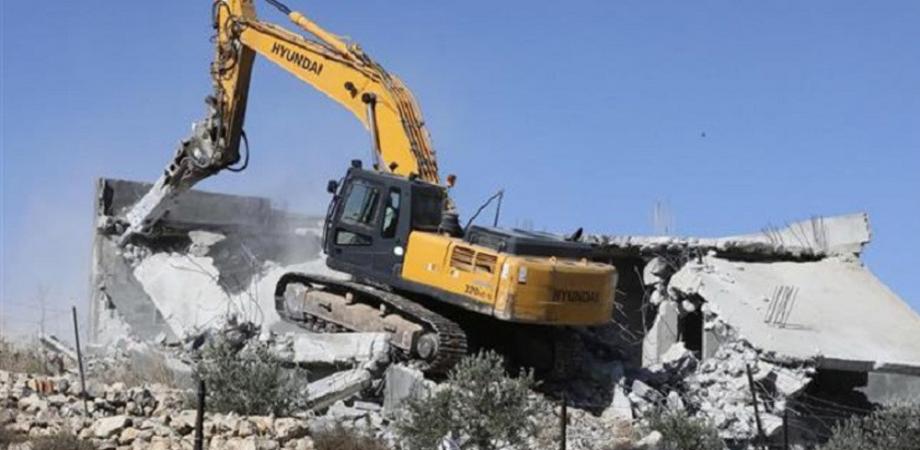The Israeli authorities demolished, forced people to demolish, or seized 178 Palestinian-owned structures across the West Bank in November; this is the highest such figure in a single month since the UN Office for the Coordination of Humanitarian Affairs (OCHA) in the occupied Palestinian territories (oPt) began systematically documenting this practice in 2009.
This month’s incidents resulted in the displacement of 158 people and otherwise affected the livelihoods or access to services of over 1,000 others, said OCHA in its monthly report on West Bank Demolitions and Displacement. All structures, except for one demolished on punitive grounds, were located in Area C of the occupied West Bank or East Jerusalem and were targeted due to a lack of building permits, which are nearly impossible for Palestinians to obtain.
Of the affected structures, 43 had been provided as humanitarian aid, for a total cost of 82,000 euros. It is the largest number of EU-funded structures targeted in a single month since January 2017, bringing the total number of such structures demolished or seized since the start of 2020 to 114.
About 50 percent of all structures targeted this month were in small herding communities in sections of Area C designated closed for Israeli military training /‘firing zones’/. The largest such incident took place on 3 November in Humsa Al Bqai’a, in the northern Jordan Valley, where the Israeli authorities demolished 83 structures, or about three-quarters of the community, including 29 structures provided as humanitarian aid. A total of 73 people, including 41 children were displaced as a result, but have been able to remain in the area following the delivery of emergency shelters and other assistance.
Additional 13 structures were targeted in the Masafer Yatta area of Hebron, most of which is also declared a ‘firing zone’. This included a donor-funded water network, part of which had already been dismantled in October, which served some 700 people from four communities. This incident took place on 25 November on the basis of an expedited procedure /Military Order 1797/, while legal partners were presenting the case in court, to try and halt the removal of the network.
Nearly 30 percent of Area C, where 38 Palestinian communities /5,000 people/ are located, is designated as ‘firing zones’. These communities, many of which have existed in the area since prior to the start of the Israeli occupation, have limited access to basic services and are at heightened risk of forcible transfer. At least 10 unauthorized Israeli settlement outposts are also located either partially or completely in ‘firing zones’.
At least nine of the structures targeted in November were dismantled and seized without prior notice. The percentage of structures seized without prior notice out of all structures targeted /demolished and seized/ has been on the rise in recent years reaching almost 30 percent in 2020. Another 13 structures /including the water network/ were demolished on the basis of Military Order 1797, which provides affected people with a shortened prior notice, of 96 hours, to try and prevent the demolition.
Also this month, the Israeli High Court extended until 15 July 2021 the deadline given to the Israeli authorities to respond to a petition filed by an Israeli settler organization, demanding the demolition of the Khan al Ahmar Bedouin community. Although technically possible, legal partners estimate that a mass demolition is not likely before that date. Khan al Ahmar is one of 18 communities to the east of Jerusalem, located within or next to an area planned for a major settlement project /E1/, which face the risk of forcible transfer.
The freeze on the demolition of inhabited homes in East Jerusalem, announced on 1 October in the context of the ongoing pandemic, was discontinued on 11 November, when the Israeli authorities demolished a home in Sur Bahir, displacing a family of five. Overall, 21 structures were demolished in East Jerusalem this month, including six by the owners, following the issuance of demolition orders.
In 2020, 47 percent of the 166 structures demolished in East Jerusalem were demolished by their owners to reduce the fines and expenses imposed by the municipality, up from an average of 23 percent between 2016 and 2019. This rise is attributed to the increased pressure exerted by the West Jerusalem Israeli municipality, which has been empowered by new Israeli legislation passed in recent years. On 11 November, however, the Ministry of Justice announced a temporary freeze of that legislation.
On 2 November, the Israeli authorities punitively demolished a Palestinian home in Area B of the West Bank, which is administered by the Palestinian Authority but remains under Israeli military control, of Rujeib village in the Nablus district, belonging to a Palestinian being prosecuted for the killing of an Israeli man in August 2020. A family of eight, including four children, was displaced as a result.
Source : Safa




